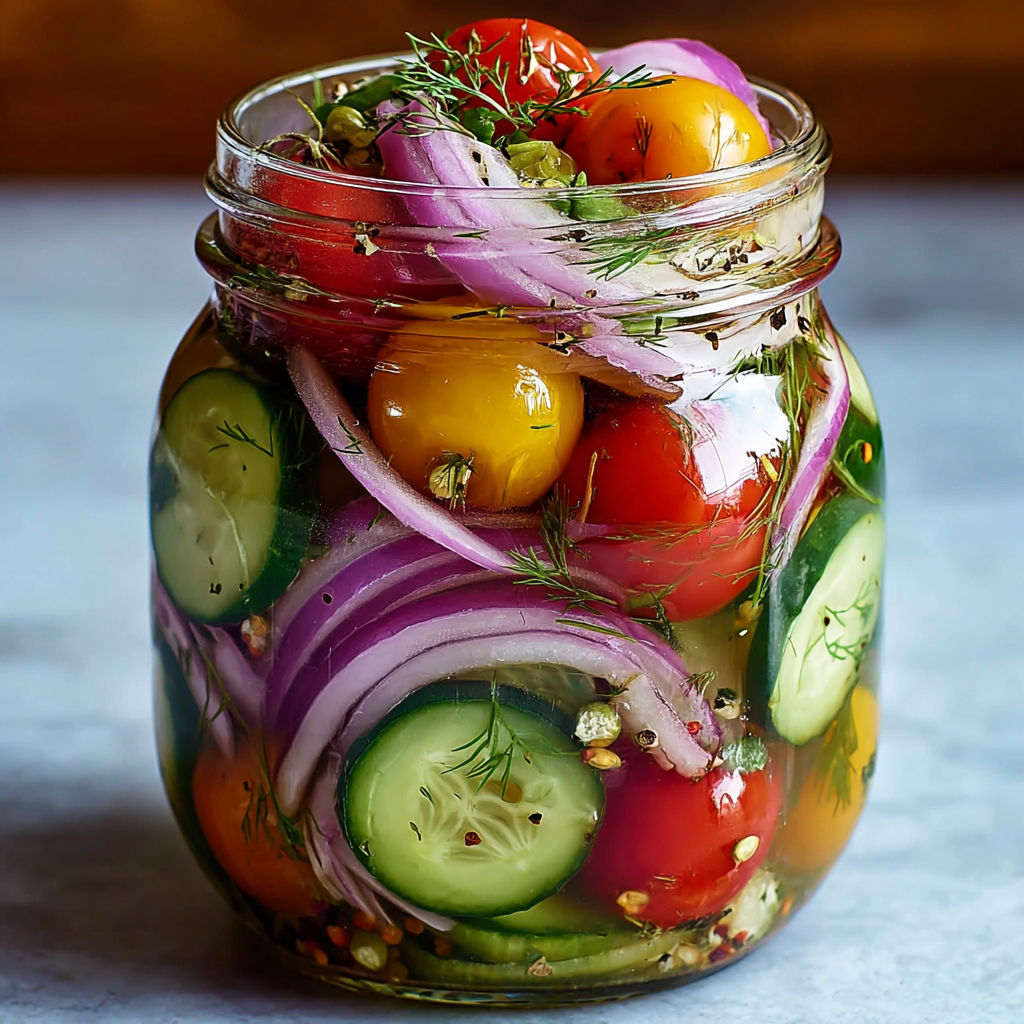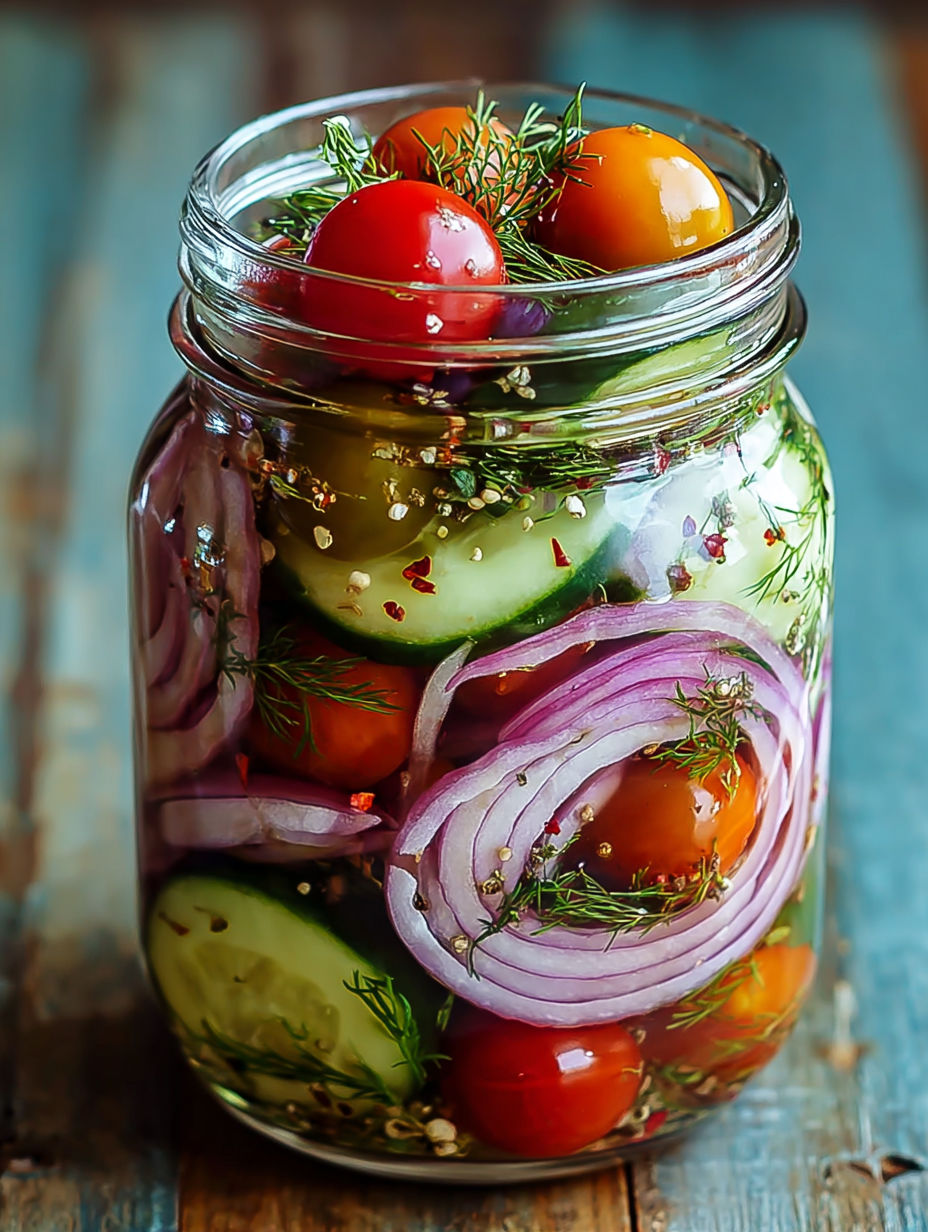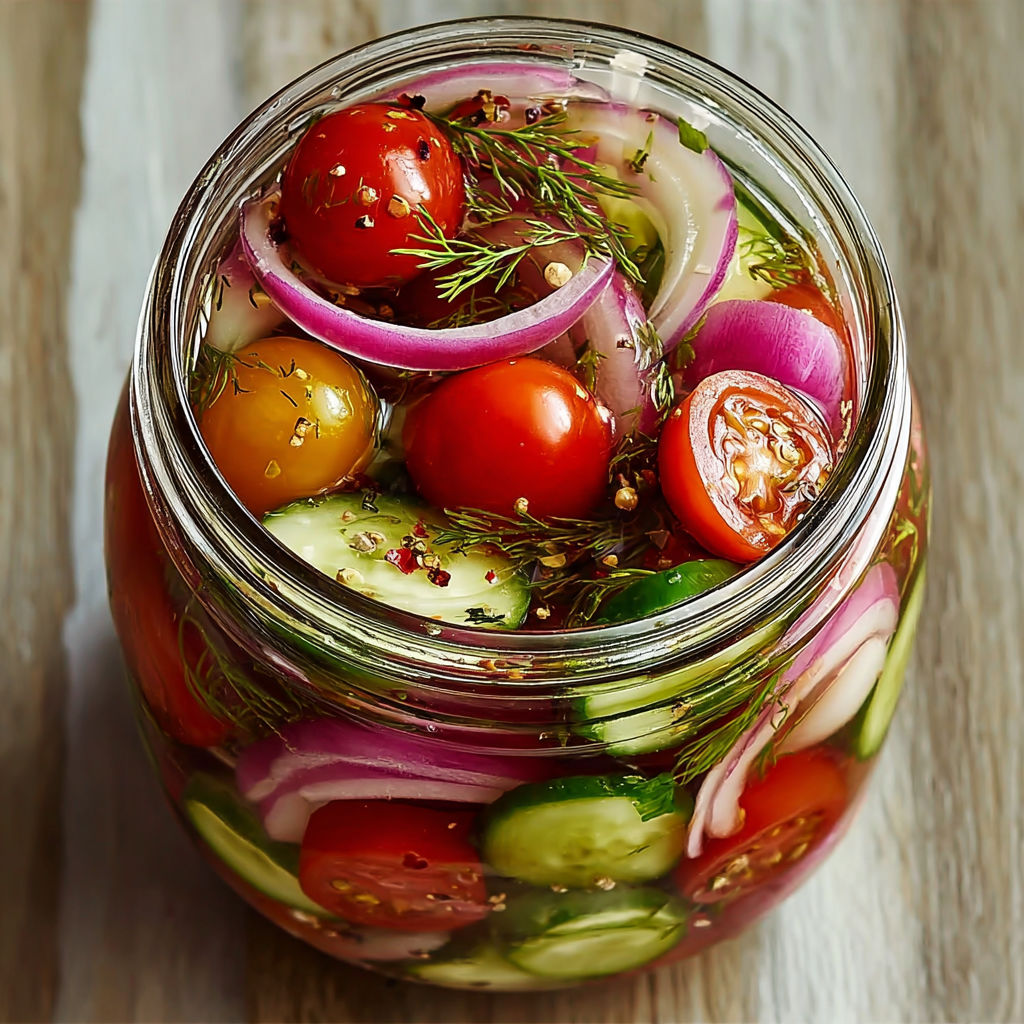 Pin
Pin
This quick pickled vegetable recipe transforms ordinary garden produce into zesty refrigerator pickles in just a couple of hours. The vibrant mix of cherry tomatoes, cucumber, and red onion creates a versatile condiment that brightens up everything from sandwiches to cheese boards with minimal effort.
I first made these pickles when my garden suddenly produced more vegetables than we could eat fresh. Now they're a staple in my refrigerator year-round because my family adds them to practically everything from tacos to salads.
- White vinegar provides the necessary acidity for safe pickling while creating that classic tangy flavor
- Sugar balances the vinegar's sharpness look for organic cane sugar for the cleanest taste
- Cherry tomatoes add bursts of sweetness use a mix of colors for visual appeal
- Red onion offers a purple hue and milder flavor than yellow varieties
- Cucumber adds refreshing crunch English cucumbers work especially well
- Fresh dill brings traditional pickle flavor fresh is vastly superior to dried for this recipe
- Salt enhances all flavors use kosher or sea salt rather than iodized table salt
- Dried oregano adds Mediterranean notes providing depth beyond basic pickles
- Red pepper flakes contribute gentle heat adjust according to your spice preference
How To Make Quick Pickled Garden Vegetables
- Prepare the vegetables
- Thoroughly wash and dry all produce to remove any dirt or residue. Slice red onions paper thin to ensure they pickle quickly and evenly. Cut cucumbers into uniform slices about 1/8 inch thick. Leave cherry tomatoes whole but prick each one with a toothpick to allow the brine to penetrate.
- Create the pickling brine
- Combine vinegar water sugar salt oregano and red pepper flakes in a saucepan over medium heat. Stir continuously until the sugar and salt completely dissolve about 3 minutes. Bring mixture to a gentle boil which helps the flavors meld together and ensures all ingredients are fully dissolved.
- Assemble the pickles
- Layer vegetables attractively in clean jars alternating colors and textures for visual appeal. Pour the hot brine directly over the vegetables ensuring they're completely submerged. The heat from the brine begins the pickling process immediately and helps soften the vegetables slightly.
- Add fresh herbs
- Sprinkle the fresh dill throughout the jar making sure it's distributed evenly. Press ingredients gently with a spoon to release any air bubbles which could prevent proper pickling. The dill will infuse throughout the entire mixture as it sits.
- Quick chill and rest
- Seal the containers tightly and allow them to come to room temperature for about 30 minutes before refrigerating. This gradual cooling helps the vegetables pickle more evenly. Refrigerate for at least 2 hours though overnight produces the best flavor development.
The vinegar brine becomes infused with vegetable flavors making it perfect for salad dressings. My grandmother taught me this trick years ago after refusing to pour out the leftover pickle brine. She would add a splash of olive oil and use it to dress simple greens. Now I always reserve at least half a cup of the infused liquid for this purpose.

Vegetable Variations
These pickles work beautifully with nearly any firm vegetable. Try cauliflower florets radishes carrots bell peppers or green beans for wonderful variations. Just remember that denser vegetables like carrots benefit from slicing them thinner to ensure they pickle properly within the quick timeframe. Some vegetables like green beans might benefit from a quick blanch before pickling to soften them slightly while maintaining their crisp texture.
Flavor Customizations
The basic brine recipe serves as an excellent canvas for creativity. Add whole garlic cloves bay leaves star anise or peppercorns for deeper complexity. Swap the white vinegar for apple cider vinegar to add fruity notes or try rice vinegar for a milder Asian-inspired version. My personal favorite variation includes two thinly sliced garlic cloves and a tablespoon of whole mustard seeds which adds wonderful texture and pops of flavor.
Serving Suggestions
These quick pickles shine on charcuterie boards adding vibrant color and tangy contrast to rich meats and cheeses. They make excellent sandwich toppers particularly with grilled cheese turkey or falafel wraps. Try them chopped and stirred into tuna salad egg salad or potato salad for brightness. I've even served them alongside rich grilled meats where their acidity cuts through fatty flavors beautifully.
Cultural Context
Quick pickling called "refrigerator pickling" differs from traditional canning methods by skipping the water bath process. This technique has been popular in many cuisines for generations particularly in Eastern European Jewish cooking where they're known as "half sours." The method allows vegetables to maintain their crisp texture and bright colors while developing that characteristic pickle tang. While traditional fermented pickles require weeks of preparation these quick pickles satisfy cravings without the wait.

Recipe FAQs
- → How long do these pickled vegetables last in the refrigerator?
The pickled vegetables will keep for up to 2 weeks when stored in an airtight container in the refrigerator. The flavor will continue to develop and intensify over time.
- → Can I use different vegetables for this pickling method?
Absolutely! This quick pickling method works well with many vegetables including bell peppers, carrots, cauliflower, green beans, and radishes. Choose vegetables with a firm texture for best results.
- → Do I have to use fresh dill or can I substitute dried dill?
While fresh dill provides the best flavor, you can substitute 1-2 tablespoons of dried dill weed. Alternatively, you could experiment with other fresh herbs like basil, tarragon, or thyme depending on your preference.
- → Can I reduce the sugar in the pickling brine?
Yes, the sugar can be adjusted to taste. You can reduce it by half or use honey or maple syrup as alternatives. Keep in mind that some sweetness helps balance the acidity of the vinegar.
- → What can I serve with these pickled vegetables?
These quick pickled vegetables make a wonderful accompaniment to sandwiches, burgers, grilled meats, charcuterie boards, grain bowls, or tacos. They also work well as a bright, tangy side dish for heavier meals.
- → Can I reuse the pickling brine?
Yes! The brine can be reused once or twice for additional batches of vegetables. Store it in the refrigerator and bring it to a boil before using it again for food safety.
